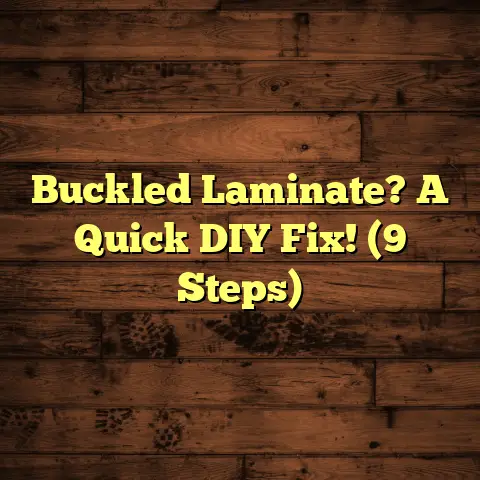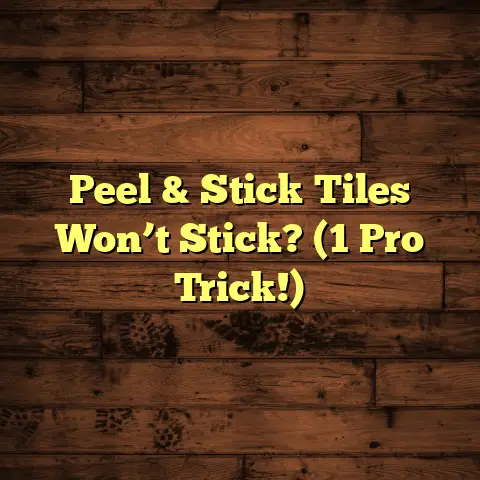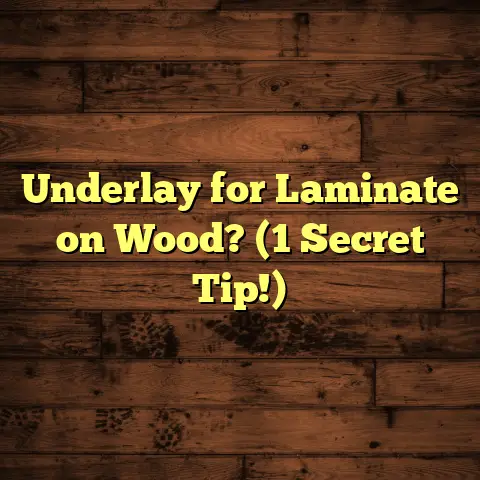Tile & Wood Entryway: Perfect Design (10 Trend Setters!)
From the grandest foyers to the coziest mudrooms, the entryway is the handshake of your home, the first impression that sets the stage for everything else.
Forget boring and bland!
The future of entryway design is all about blending functionality with artistry, creating spaces that are not only welcoming but also expressive of your unique style.
We’re talking about a revolution in flooring materials, especially tile and wood, where sustainability, technology, and pure aesthetic innovation are taking center stage.
So, buckle up as we dive into the top 10 trends that are shaping the future of tile and wood entryways!
Section 1: The Significance of Entryway Design
Why does your entryway even matter?
Think about it: it’s the first thing you see when you come home after a long day, and it’s the first thing guests experience when they enter your space.
It’s the transition zone between the outside world and your personal sanctuary.
First impressions really do matter, and your entryway is your chance to make a statement about who you are and what you value.
It’s a reflection of your personality and lifestyle.
Tile and wood are two of the most popular materials for entryways, and for good reason.
They’re durable, versatile, and offer a timeless aesthetic appeal that can complement any design style.
Plus, they’re easy to clean, which is a huge bonus in a high-traffic area like the entryway.
Section 2: Trend Setter #1: Sustainable Materials
Let’s talk about going green!
Sustainability isn’t just a buzzword anymore; it’s a way of life, and it’s transforming the flooring industry.
Eco-friendly wood and recycled tiles are leading the charge, offering homeowners a guilt-free way to create beautiful and environmentally responsible entryways.
I’ve been working with more and more clients who are specifically requesting sustainable materials, and I’m thrilled to see the industry responding with innovative products.
For example, reclaimed wood flooring is a fantastic option.
It’s sourced from old barns, factories, and even sunken logs, giving it a unique character and reducing the demand for newly harvested timber.
Recycled tiles are another great choice.
They’re made from materials like recycled glass, porcelain, and even industrial waste, diverting these materials from landfills and giving them a new life as stunning flooring.
Here are a few manufacturers that are pushing the boundaries of sustainable flooring:
- Terra Green Ceramics: Specializes in recycled glass tiles with vibrant colors and unique textures.
- EcoTimber: Offers a wide range of FSC-certified hardwood flooring sourced from responsibly managed forests.
- Plyboo: Creates bamboo flooring, a rapidly renewable resource that’s both durable and beautiful.
I recently completed a project where we used reclaimed oak flooring and recycled glass tiles in the entryway of a modern farmhouse.
The result was a stunning, eco-conscious space that perfectly blended rustic charm with contemporary design.
Section 3: Trend Setter #2: Mixed Materials
Why choose one when you can have both?
Mixing tile and wood in your entryway is a surefire way to create a visually stunning and unique space.
It’s all about playing with textures, colors, and patterns to achieve a harmonious balance that reflects your personal style.
I love seeing how designers are creatively merging these two materials to create eye-catching contrasts.
For example, you could use a wood plank border around a tile inlay to define the space and add a touch of warmth.
Or, you could create a mosaic pattern using different colored tiles and wood accents to create a truly one-of-a-kind design.
Here are some benefits of mixing materials in your entryway:
- Visual Interest: Creates a dynamic and engaging space that draws the eye.
- Functional Zoning: Defines different areas within the entryway, such as a mudroom area with durable tile and a more formal entrance with elegant wood.
- Personalization: Allows you to express your unique style and create a space that’s truly your own.
I once helped a client design an entryway with a slate tile border and a herringbone pattern wood inlay.
The combination of the cool, earthy slate and the warm, classic wood created a sophisticated and inviting space that perfectly complemented their modern home.
Section 4: Trend Setter #3: Bold Patterns and Colors
Say goodbye to boring beige!
Bold patterns and vibrant colors are making a huge comeback in entryway design, and I’m all for it.
Geometric patterns in tile flooring can instantly transform a space, adding a touch of drama and personality.
Think chevrons, hexagons, and even intricate Moroccan-inspired designs.
And don’t be afraid to experiment with color!
Vibrant color schemes can energize your entryway and create a welcoming atmosphere.
Think bold blues, sunny yellows, and even unexpected pops of pink or green.
Here are some ideas for incorporating bold patterns and colors into your entryway:
- Geometric Tile Rug: Create a focal point with a geometric tile “rug” in the center of your entryway.
- Colorful Grout: Use colored grout to highlight the pattern of your tiles and add an unexpected twist.
- Painted Wood Accents: Paint wood trim or wainscoting in a bold color to complement your tile flooring.
I recently worked on a project where we used a vibrant blue and white geometric tile pattern in the entryway of a beach house.
The result was a fun, energetic space that perfectly captured the spirit of the coast.
Section 5: Trend Setter #4: Smart Technology Integration
The future is now!
Technology is changing the way we design and interact with our homes, and entryways are no exception.
Smart floor heating systems, lighting, and even security features can be seamlessly integrated into tile and wood designs, creating a truly connected and convenient space.
Imagine stepping into your entryway on a cold winter morning and being greeted by warm, toasty floors.
Or, having your entryway lights automatically turn on as you approach the door.
These are just a few examples of how smart technology can enhance your entryway experience.
Here are some smart technology features you can incorporate into your entryway:
- Smart Floor Heating: Control your floor heating system remotely with your smartphone.
- Smart Lighting: Use motion sensors to automatically turn on lights as you enter the space.
- Smart Security: Integrate your entryway with your home security system for added peace of mind.
I’m currently working on a project where we’re installing a smart floor heating system in the entryway of a modern condo.
The client is thrilled about the idea of being able to control the temperature of their floors from their phone, ensuring a comfortable welcome every time they come home.
Section 6: Trend Setter #5: Minimalist Aesthetics
Less is more!
The minimalist trend is all about simplicity, clean lines, and functional design.
In the entryway, this translates to uncluttered spaces, simple color palettes, and carefully chosen furniture that complements the tile and wood flooring.
Think sleek, modern tiles in neutral tones, paired with light-colored wood accents and minimal décor.
The goal is to create a calming and inviting space that feels both spacious and serene.
Here are some tips for creating a minimalist entryway:
- Choose a Neutral Color Palette: Stick to whites, grays, and beiges for a clean and timeless look.
- Declutter: Keep the space free of unnecessary items and clutter.
- Invest in Functional Furniture: Choose furniture that serves a purpose, such as a bench with built-in storage or a sleek console table.
I recently helped a client design a minimalist entryway with large-format porcelain tiles in a light gray color.
We paired the tiles with a simple white bench and a few strategically placed plants to create a calming and inviting space that perfectly reflected their minimalist lifestyle.
Section 7: Trend Setter #6: Vintage and Retro Influences
Everything old is new again!
Vintage and retro styles are making a big comeback in flooring, adding character and charm to entryways.
Think antique tiles, reclaimed wood, and patterns inspired by the mid-century modern era.
These nostalgic styles can create a warm and inviting atmosphere, evoking a sense of history and authenticity.
Here are some ways to incorporate vintage and retro influences into your entryway:
- Antique Tiles: Source antique tiles from architectural salvage yards or online marketplaces.
- Reclaimed Wood: Use reclaimed wood flooring or wainscoting to add a rustic touch.
- Mid-Century Modern Patterns: Choose tile patterns inspired by the mid-century modern era, such as geometric shapes and bold colors.
I recently worked on a project where we used reclaimed barn wood flooring and antique encaustic tiles in the entryway of a Victorian home.
The result was a stunning and unique space that perfectly captured the home’s historic character.
Section 8: Trend Setter #7: Indoor-Outdoor Flow
Blurring the lines!
Creating a seamless transition between indoor and outdoor spaces is a growing trend, especially in climates that encourage outdoor living.
Tile and wood can be used to enhance this flow, creating a cohesive and inviting space that connects your home with the natural world.
Think large-format tiles that extend from your entryway to your patio, or wood decking that seamlessly transitions from your living room to your outdoor deck.
Here are some tips for creating an indoor-outdoor flow in your entryway:
- Use the Same Flooring Material: Extend the same flooring material from your entryway to your outdoor space for a seamless transition.
- Choose a Neutral Color Palette: Use a neutral color palette that complements both your indoor and outdoor spaces.
- Incorporate Natural Elements: Add plants, water features, and other natural elements to blur the lines between indoors and out.
I recently helped a client design an entryway with large-format porcelain tiles that extended from their entryway to their covered patio.
We also installed a sliding glass door that opened up the space, creating a seamless transition between indoors and out.
Section 9: Trend Setter #8: Textured Finishes
Feel the difference!
Textured flooring is all about adding depth and interest to your entryway.
Various finishes are available for tile and wood that enhance tactile experiences, creating a more engaging and inviting space.
Think hand-scraped wood flooring, textured tiles with raised patterns, or even natural stone with a rough, unfinished surface.
Here are some examples of textured finishes for tile and wood:
- Hand-Scraped Wood: Adds a rustic and tactile feel to wood flooring.
- Textured Tiles: Features raised patterns or grooves that add depth and interest.
- Natural Stone: Offers a unique and organic texture that varies from piece to piece.
I recently worked on a project where we used hand-scraped hickory flooring in the entryway of a mountain cabin.
The textured finish added a rustic and inviting feel that perfectly complemented the cabin’s natural surroundings.
Section 10: Trend Setter #9: Custom Designs
Make it your own!
Customization is on the rise in flooring, with homeowners seeking bespoke tile patterns and custom wood cuts that reflect their individual tastes and lifestyles.
Personalized entryway designs can create a truly unique and memorable space that sets your home apart.
Think custom mosaic tile patterns, personalized wood inlays, or even hand-painted tile murals.
Here are some ideas for creating a custom entryway design:
- Custom Mosaic Tile Pattern: Design a unique mosaic tile pattern that reflects your personal style.
- Personalized Wood Inlay: Incorporate a personalized wood inlay with your initials or a meaningful symbol.
- Hand-Painted Tile Mural: Commission a hand-painted tile mural that tells a story or reflects your artistic sensibilities.
I recently helped a client design a custom mosaic tile pattern for their entryway that incorporated their family crest.
The result was a stunning and personal space that truly reflected their family’s history and heritage.
Section 11: Trend Setter #10: Multi-Functional Spaces
More than just a hallway!
Entryways are no longer just a passage from the outside world to your home.
They’re becoming multi-functional spaces that serve as more than just a hallway.
Tile and wood can be used to design spaces that include storage, seating, and even decorative elements, maximizing utility and creating a more inviting and practical entryway.
Here are some ideas for creating a multi-functional entryway:
- Built-In Storage: Incorporate built-in storage for shoes, coats, and other items.
- Seating Area: Add a bench or chair to create a comfortable seating area.
- Decorative Elements: Incorporate artwork, plants, and other decorative elements to personalize the space.
I recently helped a client design an entryway with built-in storage for shoes and coats, a comfortable bench for seating, and a decorative console table with a vase of flowers.
The result was a functional and inviting space that served as a true extension of their home.
Conclusion: The Future of Tile & Wood Entryways
So there you have it, folks!
The top 10 trends that are shaping the future of tile and wood entryways.
From sustainable materials to smart technology integration, the possibilities are endless.
I encourage you to think creatively about your own entryway and consider how these trends can inspire your personal design choices.
Whether you’re looking to create a minimalist oasis, a vibrant and energetic space, or a cozy and inviting retreat, tile and wood offer endless possibilities for creating an entryway that’s both beautiful and functional.
So go ahead, embrace these trends, and create an entryway that truly reflects your unique style and personality!
Happy designing!





